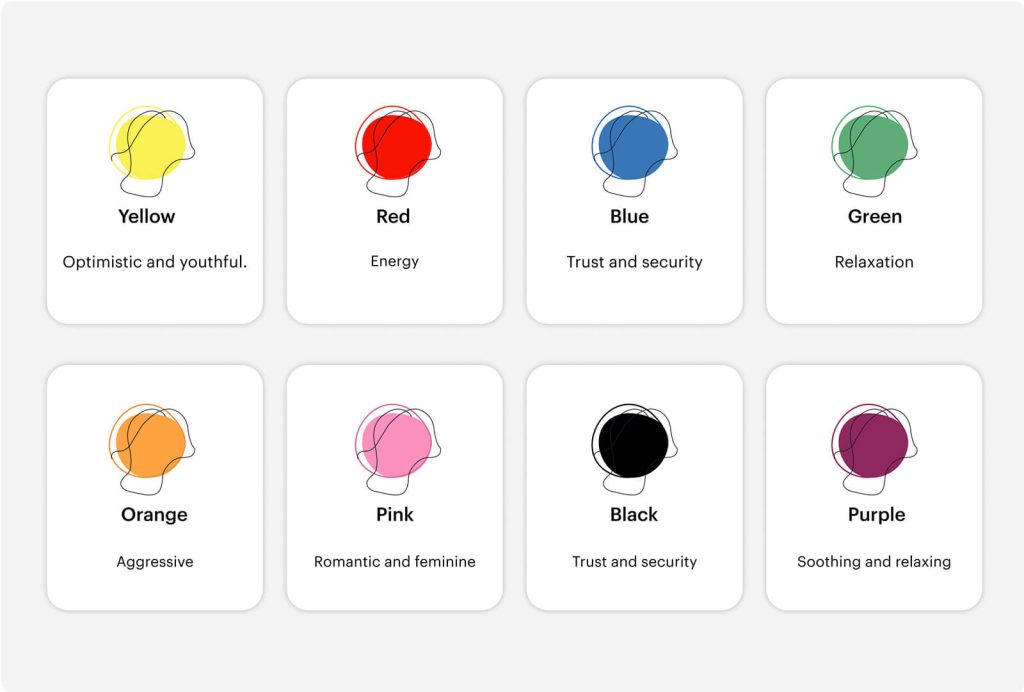
When it comes to making a lasting impression on users, the role of colors is undeniable. Color plays a critical role in the visual experience as it’s the most effortless element a human remembers while coming across new things. Every moment, we come across objects of various colors fighting to grab our attention. Colors serve as a critical knowledge medium that supports our cognitive system and helps humans make decisions. Colors affect us mentally and physically, with each color denoting specific emotions. A business must delve deeper into the color psychology in design as it boosts the branding and marketing efforts of the brand. The apt selection and placement of colors create a positive impact on the customers. In turn, it contributes to the growth of an organization. But what is the psychology of color? How does a business benefit from colors and culture?
What is color psychology?
Color psychology is a branch of study that involves learning how particular colors impact human behavior, emotions, and perceptions. Colors have different meanings, definitions, and psychological impacts across cultures. Color psychology in branding and marketing is an attractive area of study where businesses invest, as using colors wisely can persuade customers and positively impact brand perception. Color psychology involves using color theory, a practical application of mixing and matching various color hues to explore more perspectives and effects. The wise usage of color psychology in UX is a powerful tool that business leaders use to communicate the essential essences of a brand.
Why does color psychology matter in branding and marketing?
Color psychology plays an integral role in a company’s branding and marketing efforts. Business leaders and designers make the best use of color psychology in design to craft compelling marketing strategies. But what does color psychology in UX mean to a brand? How can a business make the best use of colors and emotions to boost its marketing efforts?
Color influences feelings
Colors and emotions are closely connected, as colors can influence our sentiments. Colors evoke our feelings, which brands leverage to bond with their customers. Each color evokes different emotions.
Understanding color psychology, brands use color to create an impact on their audience. For example, red symbolizes love, passion, and energy. That’s the psychology behind brands using red gift wrappers and themes for Valentine’s Day. Real estate firms tend to use the color blue, denoting trust and professionalism. Various brands use green as it symbolizes eco-friendliness. The same applies to other colors, which evoke different emotions.
Your user’s vision matters
Color palettes play a vital role while designing the UI/UX of a mobile or web app, as companies give priority to the user’s vision. No enterprises want its customers to get a migraine while traversing through their app instead of having a pleasant experience. Business leaders and designers must remember that the user’s eyes matter while picking the right colors.
Clashing bold colors next to each other often causes an unpleasant experience. Designers often opt for lighter, less violent colors and pastel themes, which is a trend of creating a smoothing effect. The main principle of creating a pleasant experience is not overcrowding your app with colors but keeping them minimalistic.
Colors can make your brand stand out
The usage of colors highlights a brand’s personality and separates them from competitors. Picking the color must align with the brand’s mission and values while giving the organization an identity. Furthermore, the colors let your audience grasp what you intend to convey.
Here is why choosing the right colors makes your brand a standout.
First impressions and purpose clarity
The first impression is always the best impression. According to a study by WebpageFX, most users make judgments about a website within 90% of viewing it. Most surprisingly, 62%-90% of users make a decision based on color.
The apt use of colors in the user interface or user experience (UI/UX) is critical in grabbing the customers’ attention and keep them hooked to your application and brand. Color usage speaks for the brand’s purpose with clarity, enabling users to understand and connect with the brand smoothly.
Defines the brand perspective
Top organizations picking color schemes, issuing brand guidelines, and striving to keep their design consistent across their site and communication channels come with a reason. Colors change how people view brands, with even a small change making a massive impact. According to a study by Kissmetric, color is 80% of the reason for brand recognition.
An organization must decide upon its color schemes and keep them consistent. The colors create a permanent impression of the enterprise and communicate what value they represent.
Influence sales
Colors influence more than a brand perception, but easily the customers’ buying habits too. 85% of the customers feel that color plays an undeniable role in influencing their purchasing ways. For example, the color of a car is an integral component when a customer opts for a vehicle. Similarly, the color templates of eCommerce sites influence a customer to make more purchases and up the conversion rate of the business.
Reaching the right demographics
Every color serves various purposes or conveys different emotions as per demographics. A company must learn color psychology to utilize color palettes and hues to suit the right audience and gain more leads. Let’s see how choosing the apt colors impacts your audiences according to their gender, culture, age, and buying habits.
Gender
If your target audience or demographics tilts between genders, color psychology plays a more extensive role in the business.
According to Kissmetric, most men and one-third of women prefer blue. Neutral colors like black, white, and grey or the classic red, green, and blue attract all genders. Women prefer purple over men. Meanwhile, orange and brown are the least favorite among the genders.
Age
The color appeal varies per age group, prompting businesses to be careful while selecting colors.
High-contrast colors with brighter hues, particularly red, blue, and yellow, attract younger audiences. As we grow, the preferences shift to pastel colors, with pink and teal. However, brown and orange are the colors to avoid, no matter the age group.
Culture
Colors and culture go hand-in-hand. When an organization targets an international audience, the research into color psychology must be in-depth. The meaning of color varies with cultures and geographies. For example, the USA views blue as something positive, while Iran associates the color with mourning.

The importance of white spaces
Similar to color, white space usage is critical for an organization to attract and satisfy more customers. Designers and business leaders focus on giving whitespaces the appreciation it deserve.
The area between elements (text, images, icons, and more) on a web page, whitespace, gives websites a simple, clean, minimalist look that makes them desirable among the audience. Whitespaces boost the website content, making it aesthetically pleasing, more digestible, and attractive to users. Whitespaces often bring balance to the website while constructing a natural flow of user navigation. Whitespaces let elements spread out and shine on the webpage.
Conclusion
Colors play a critical role in the growth of a business and an application gaining attraction. Organizations must understand color psychology in UI/UX to offer a memorable user experience. Want to know more about the role of colors in UX? Let’s take your journey one step ahead.
Case Studies
Let our work do the talking
Learn about the instances where we were able to create an impact, raising the bar on the standards we set for ourselves.

88&8 —Design, It’s all about trust.
Power of design to create possibilities that
define a preferable future for companies,
cities and societies.
Insights
The information technology times
Have a read on groundbreaking figments of imagination of the brightest minds that have been brought to life.
How can we help you?
Get in touch and let’s find out how we can curate our offerings to match your organization’s needs.
Get in touchSign up for our latest insights.
Never miss an insight. We’ll email you when new articles are published.
Subscribe.
Thanks for subscribing to PiServe Insights.
Please fill in the details.









